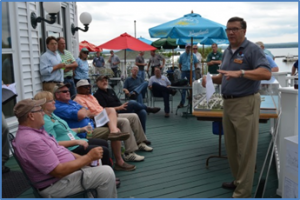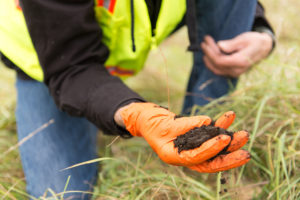Are you a local government representative searching for brownfield funding? Wondering what federal brownfield financial assistance is available beyond the EPA? In this webinar, Leveraging Resources for Brownfields Revitalization: Meet the Funders – Economic Development, you will hear from federal agencies such as the US Dept. of Housing and Urban Development, US Dept. of Agriculture-Rural Development and the US Economic Development Administration (part of US Dept. of Commerce), about practical and immediately useful information about the type of funding available and how to apply for it.
Brownfields Redevelopment
DNR Brownfields “Annual Accomplishments” Report Available
The RR Program’s annual brownfields accomplishments report to US EPA, which details outputs and outcomes funded by a federal grant, is now available. The Section 128(a) Grant Final Accomplishments Report, for the reporting period of September 1, 2015 to August 31, 2016, highlights work completed in past the funding year. Since 2003, the RR Program has consistently and efficiently used these funds to enhance state efforts with brownfields cleanup and redevelopment.
Previous 128(a) reports can be found on the Brownfields Program webpage.
Updated VPLE Insurance Fees
The Voluntary Party Liability Exemption (VPLE) Insurance fee schedule (RR-661) is now updated and available on the DNR website. The VPLE program allows anyone to conduct an assessment and remedial action of an entire property with DNR oversight to obtain a liability exemption. Insurance is required for VPLE sites where groundwater contamination levels are above enforcement standards and the DNR determines that natural attenuation will restore groundwater quality.
The new insurance fees have gone down slightly and will be in effect until November 1, 2018. The application form, process, and the former use categories (commercial, light industrial, etc.) remain the same.
VPLE insurance is now provided through Ironshore Insurance Services. Any questions about this insurance requirement should be directed to Michael Prager, (608) 261-4927.
2016 VPLE Report Now Available
The DNR Remediation and Redevelopment program has prepared a biannual report on the Voluntary Party Liability Exemption (VPLE) program. The report, required by law, provides the legislature and the Governor information about the performance of the VPLE program. The Program, which has helped many brownfields redevelopment projects across the state, allows for anyone to conduct an environmental investigation and remedial action of an entire property with DNR oversight and receive exemptions from liability. The report is available here: http://dnr.wi.gov/files/PDF/pubs/rr/RR929.pdf
Cleanup and Redevelopment in the NRB Spotlight in Ashland

Northern Region RR Program Team Supervisor John Robinson provides members of the Natural Resources Board with an update on the cleanup work at the Ashland/NSP Superfund site during the Board’s August 2-3, 2016 tour and meeting in northern Wisconsin.
Natural Resources Board members got an up close look at the Northern States Power (NSP) Superfund site during the Board’s August meeting and tour in Ashland. DNR and the US EPA have been managing work on this lakefront site since contamination was discovered in the late 1980s. Phase I of the cleanup was completed in 2014, with groundwater monitoring continuing for several years. Phase II includes cleaning up impacted sediment from near the shoreline, with a “wet dredge” pilot project underway and scheduled to be completed later this year.
During the Board’s formal meeting on the second day of its visit, DNR Sec. Cathy Stepp announced that the City of Ashland had officially received a mix of brownfields redevelopment awards totaling nearly $450,000. The awards, from DNR’s Ready for Reuse and Wisconsin Assessment Monies programs were provided to help the community assess and clean up several properties and get them ready for redevelopment. Read the full press release.
Politico Magazine: How Milwaukee Shook Off the Rust
A multi-page spread in Politico highlights the redevelopment challenges and successes of the Menomonee River Valley industrial site in Milwaukee. Writer Colin Woodard traces the transformation of the four-mile long, half-mile wide tract of land from its industrial beginnings in the mid-1880s to its recent industrial and commercial rebirth.
No Increase to VPLE Review Fee for FY17
The Remediation and Redevelopment Program has recalculated the hourly review fee rate for sites in the Voluntary Party Liability Exemption (VPLE) program. As required by law (Wis. Admin. § NR 750.07), the fee is calculated each year using the rates for current wages, fringe and indirect costs. The rate will not change for the upcoming year and will continue to be $105/hour for the state fiscal year 2017 which began July 1, 2016 and ends June 30, 2017. This rate has remained unchanged since July 2014.
The Wisconsin DNR’s VPLE program allows for anyone to conduct a complete investigation and remedial action of a piece of property and receive an exemption from future liability that is transferable to future property owners. Participants in the VPLE program pay this fee for DNR staff to provide technical oversight of the work conducted as part of the remediation process.
More information about the VPLE program is available on the RR Program website: http://dnr.wi.gov/topic/brownfields/vple.html.
DNR Brownfields Program Releases New Video Highlighting Cleanup and Redevelopment Successes
The DNR brownfields program is pleased to present “Beans & Brew,” a seven-minute video highlighting the remediation and redevelopment efforts undertaken by Milwaukee’s Colectivo Coffee and the Potosi Brewery. These two stories highlight the impressive impact of collaboration between private industry, local public sector supporters and the DNR.
Over 20 years of experience has shown that cleanups are both possible and profitable. The environment and the economy can benefit together, as confirmed by a recent UW-Whitewater study.
Beans & Brew is the brownfields program’s most recent video to highlight a successful cleanup and redevelopment project in Wisconsin. Other videos can be seen on the agency’s YouTube channel. Write-ups on these and 101 additional successful redevelopment stories are available at http://dnr.wi.gov/topic/Brownfields/Success.html.
Brownfields Study Group Co-Chair Dave Misky Honored With Public Policy Award
Citing his creative solutions to solving complex redevelopment challenges, the Public Policy Forum has chosen David Misky, Assistant Executive Director-Secretary for the Redevelopment Authority of the City of Milwaukee (RACM) and the Co-Chair of the Wisconsin Brownfields Study Group, as the recipient of the 2016 Norman N. Gill Award for Individual Excellence. The award will be presented at the Forum’s “Salute to Local Government” event on June 21, 2016 in Milwaukee.
Misky joined RACM in 2003 and was appointed Assistant Executive Director-Secretary in 2008. He led the agency’s redevelopment efforts in the Menomonee Valley, the Villard Library project, the 440th Local Redevelopment Plan and on efforts at Century City and the Harbor District. Under his leadership, RACM has been a national leader in securing federal brownfield grants and Milwaukee has become an EPA “showcase community.” He also helped to organize a unique Brownfield Revolving Loan Fund and has played a leading role in the city’s efforts to aggressively address tax delinquent and blighted properties.
Established in 1913 as a good government watchdog, the Public Policy Forum is a private, non-profit, independent research organization dedicated to enhancing the quality of public policy decision-making in southeast Wisconsin.
As Co-Chair of the Brownfields Study Group, Misky helps lead a wide-ranging group of professionals evaluating the state’s current brownfields policies and, where necessary, recommending changes and proposing additional incentives for the cleanup and reuse of abandoned or underused properties with real or perceived contamination.
Brownfield Awards go to Three Communities in Wisconsin
Three Wisconsin Assessment Monies (WAM) Contractor Services Awards were awarded to assess contamination at two former wood-processing plants and a former creamery in Clark, Lincoln and Rusk counties.
The projects are valued up to $18,000 each. The services will be used to determine soil and groundwater conditions at the former Owen Manufacturing wood-processing plant in Clark County; the former Hurd Manufacturing facility in Merrill/Lincoln counties; and at the former Sheldon Creamery in Rusk County.
See the full article for more information.
